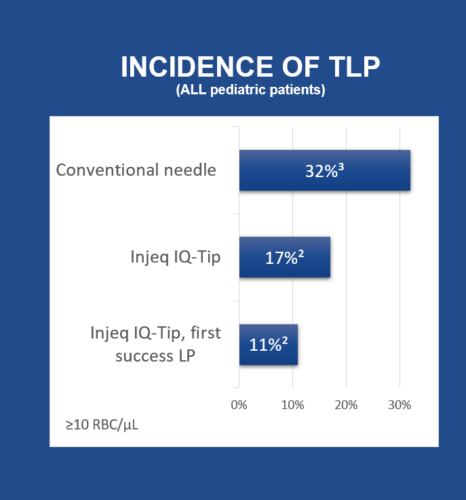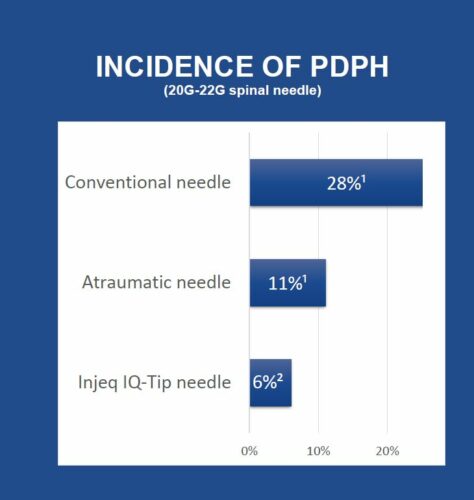Injeq IQ-Tip®
Innovative lumbar puncture technique with CSF detection
Smart needle with bioimpedance based tissue recognition
Injeq system performs continuous bioimpedance spectroscopy measurement of tissues that are in immediate contact with the electrodes at the needle tip. The bar graph and the conductivity index shown on the display indicate a relative electrical conductivity of the tissue in contact with the needle tip. The higher the number, the higher the conductivity of the tissue.
Cerebrospinal fluid (CSF) has the highest electrical conductivity of any tissue in the lumbar region. Thus, conductivity index value is high: 70 – 99, when the needle tip is in contact with CSF. Conductivity index values of other tissues, such as blood, muscles and ligaments, are clearly below these values.
Fat has low electrical conductivity, so the Conductivity Index value is also low: 10 – 20. In addition to subcutaneous fat, there is usually some fat in the epidural space, which may be indicated by the low conductivity index values. If this occurs, the doctor can recognize that the needle tip is approaching the spinal canal and after perforation of dura mater, the CSF detection should occur.
With Injeq IQ-Tip® it is possible to get the puncture right the first time, every time.
This technology was studied with 152 lumbar punctures among acute lymphoblastic leukemia (ALL) children
The observations from this study show good first puncture success rate and remarkably low incidence of post-dural puncture headache (PDPH) – only 6% (2) – compared to conventional Quincke type needles with 28 % (1) or pencil-point needles with 11% (1) incidence reported in the same-size 22G needles. See the graph on the right.

IQ-Tip system is associated with significantly lower incidence of traumatic lumbar punctures (TLP) compared to conventional needles.
In the study by Långström et al., only 17% of lumbar punctures were traumatic according to the strictest criterion of <10 RBC/μL in the CSF sample. This result compares favorably to a large register-based study by Sievänen et al reporting 32% incidence in pediatric hemato-oncological patients. The meta-analysis by Nath et al. shows that the incidence of TLP does not differ between the conventional needle and atraumatic needle.
- Nath et al. 2018. Atraumatic versus conventional lumbar puncture needles: a systematic review and meta-analysis. Lancet 2018
- Långström et al. 2022. Bioimpedance spinal needle provides high success and low complication rate in lumbar punctures of pediatric patients with acute lymphoblastic leukemia. Scientific Reports, 2022.
- Sievänen, H., et al. 2022. Traumatic lumbar punctures in diagnostic and intrathecal treatment punctures of pediatric hemato-oncology patients, Pediatric Hematology and Oncology, 2022
The latest Injeq news and activity
Tiedote osakkeenomistajille / Notice to shareholders
TIEDOTE INJEQ OYJ:N OSAKKEENOMISTAJILLE NOTICE TO SHAREHOLDERS OF INJEQ PLC
Read more »

News release on April 12, 2024
The share issue of Injeq Plc. ended on April 5, 2024, and the investment round did not achieve the goals […]
Read more »

Information to shareholders, March 22nd, 2024
Injeq has started a share issue. The maximum of the financing round is set at €3,000,000. If the €2,000,000 goal […]
Read more »

Injeq webinars by Dr Sauli Palmu and Dr Harri Sievänen
Injeq webinar videos are now available! Welcome to participate in Dr. Sauli Palmu’s lecture “Lumbar punctures in pediatric hemato-oncology” (part […]
Read more »
"Traumatic lumbar punctures are especially problematic, since they may introduce leukemia cells from blood to the central nervous system."
Because Every Procedure Matters
- Knowing that the needle tip is in the right place, you can avoid repeated, inconvenient punctures. Not only for patients with leukemia but also for newborn babies to whom lumbar punctures are particularly challenging.
- Avoiding unnecessary needle movements in spinal area with low incidence of blood-contaminated CSF samples
- Only 6% incidence of post-dural puncture headache – among the lowest incidences reported with the same-size needle of any type.
- Enabling technology for further applications.


